Literature Review: Machining Force Models for Metal Matrix Composites
VerifiedAdded on 2023/03/21
|10
|1890
|70
Literature Review
AI Summary
This literature review focuses on machining force models developed for aluminum and magnesium-based metal matrix composites (MMCs). It discusses the challenges in machining MMCs due to the abrasive nature of the reinforcement and high machining costs. The review covers face milling tests conducted on aluminum-based MMCs using coated carbide cutting tools, examining the impact of varying feed rates, width of cut, and depth of cut under constant cutting speed. Key concepts such as cutting force, primary and secondary cutting forces, and the chip forming process are defined. The experimental setup, including materials, equipment, and procedures used in the face milling tests, is detailed, along with the development of finite element models using ABAQUS to simulate the machining process. The review also includes information on the Cook and Johnson constitutive model used for the matrix material and the cohesive zone element method for simulating chip separation. The document concludes with a list of references used in the review.
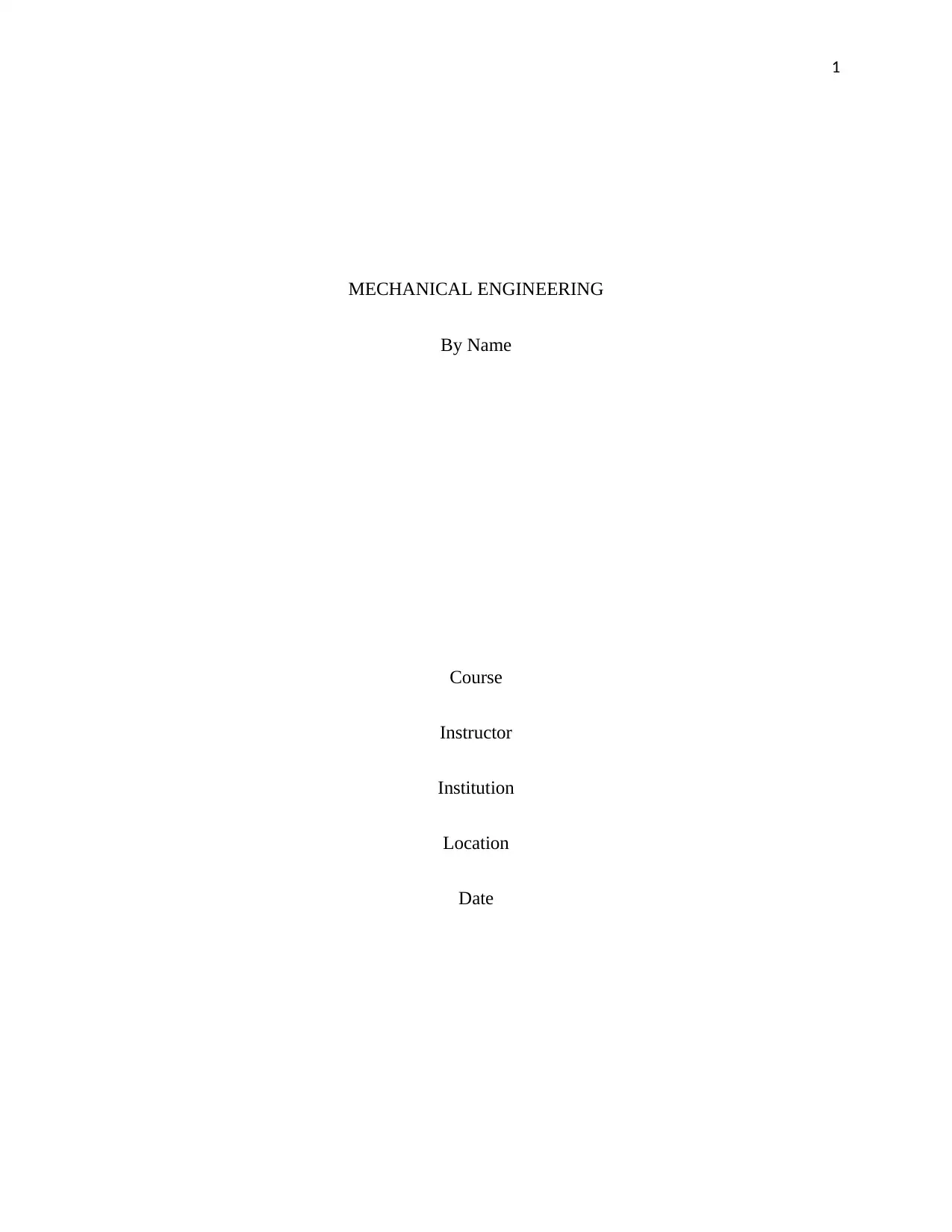
1
MECHANICAL ENGINEERING
By Name
Course
Instructor
Institution
Location
Date
MECHANICAL ENGINEERING
By Name
Course
Instructor
Institution
Location
Date
Paraphrase This Document
Need a fresh take? Get an instant paraphrase of this document with our AI Paraphraser
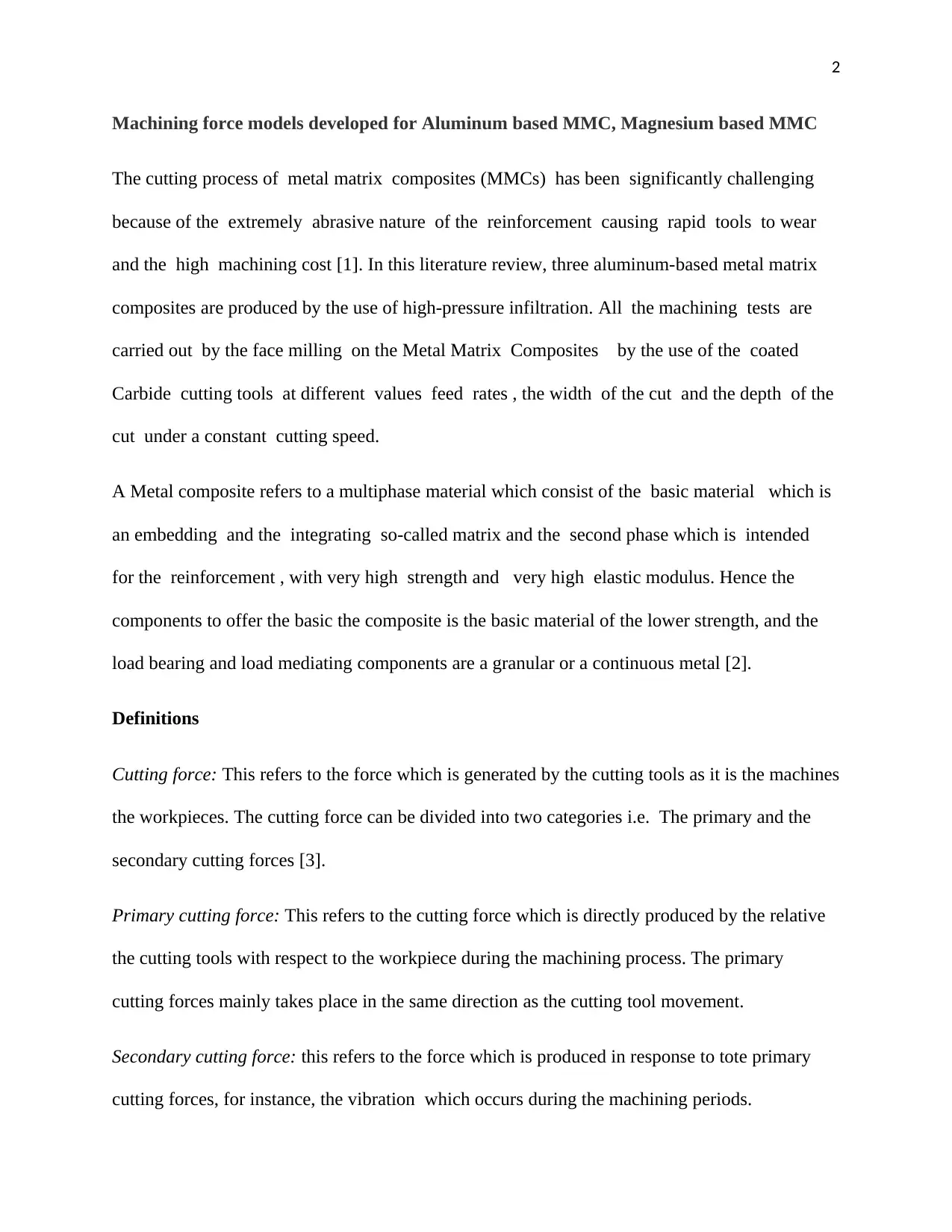
2
Machining force models developed for Aluminum based MMC, Magnesium based MMC
The cutting process of metal matrix composites (MMCs) has been significantly challenging
because of the extremely abrasive nature of the reinforcement causing rapid tools to wear
and the high machining cost [1]. In this literature review, three aluminum-based metal matrix
composites are produced by the use of high-pressure infiltration. All the machining tests are
carried out by the face milling on the Metal Matrix Composites by the use of the coated
Carbide cutting tools at different values feed rates , the width of the cut and the depth of the
cut under a constant cutting speed.
A Metal composite refers to a multiphase material which consist of the basic material which is
an embedding and the integrating so-called matrix and the second phase which is intended
for the reinforcement , with very high strength and very high elastic modulus. Hence the
components to offer the basic the composite is the basic material of the lower strength, and the
load bearing and load mediating components are a granular or a continuous metal [2].
Definitions
Cutting force: This refers to the force which is generated by the cutting tools as it is the machines
the workpieces. The cutting force can be divided into two categories i.e. The primary and the
secondary cutting forces [3].
Primary cutting force: This refers to the cutting force which is directly produced by the relative
the cutting tools with respect to the workpiece during the machining process. The primary
cutting forces mainly takes place in the same direction as the cutting tool movement.
Secondary cutting force: this refers to the force which is produced in response to tote primary
cutting forces, for instance, the vibration which occurs during the machining periods.
Machining force models developed for Aluminum based MMC, Magnesium based MMC
The cutting process of metal matrix composites (MMCs) has been significantly challenging
because of the extremely abrasive nature of the reinforcement causing rapid tools to wear
and the high machining cost [1]. In this literature review, three aluminum-based metal matrix
composites are produced by the use of high-pressure infiltration. All the machining tests are
carried out by the face milling on the Metal Matrix Composites by the use of the coated
Carbide cutting tools at different values feed rates , the width of the cut and the depth of the
cut under a constant cutting speed.
A Metal composite refers to a multiphase material which consist of the basic material which is
an embedding and the integrating so-called matrix and the second phase which is intended
for the reinforcement , with very high strength and very high elastic modulus. Hence the
components to offer the basic the composite is the basic material of the lower strength, and the
load bearing and load mediating components are a granular or a continuous metal [2].
Definitions
Cutting force: This refers to the force which is generated by the cutting tools as it is the machines
the workpieces. The cutting force can be divided into two categories i.e. The primary and the
secondary cutting forces [3].
Primary cutting force: This refers to the cutting force which is directly produced by the relative
the cutting tools with respect to the workpiece during the machining process. The primary
cutting forces mainly takes place in the same direction as the cutting tool movement.
Secondary cutting force: this refers to the force which is produced in response to tote primary
cutting forces, for instance, the vibration which occurs during the machining periods.
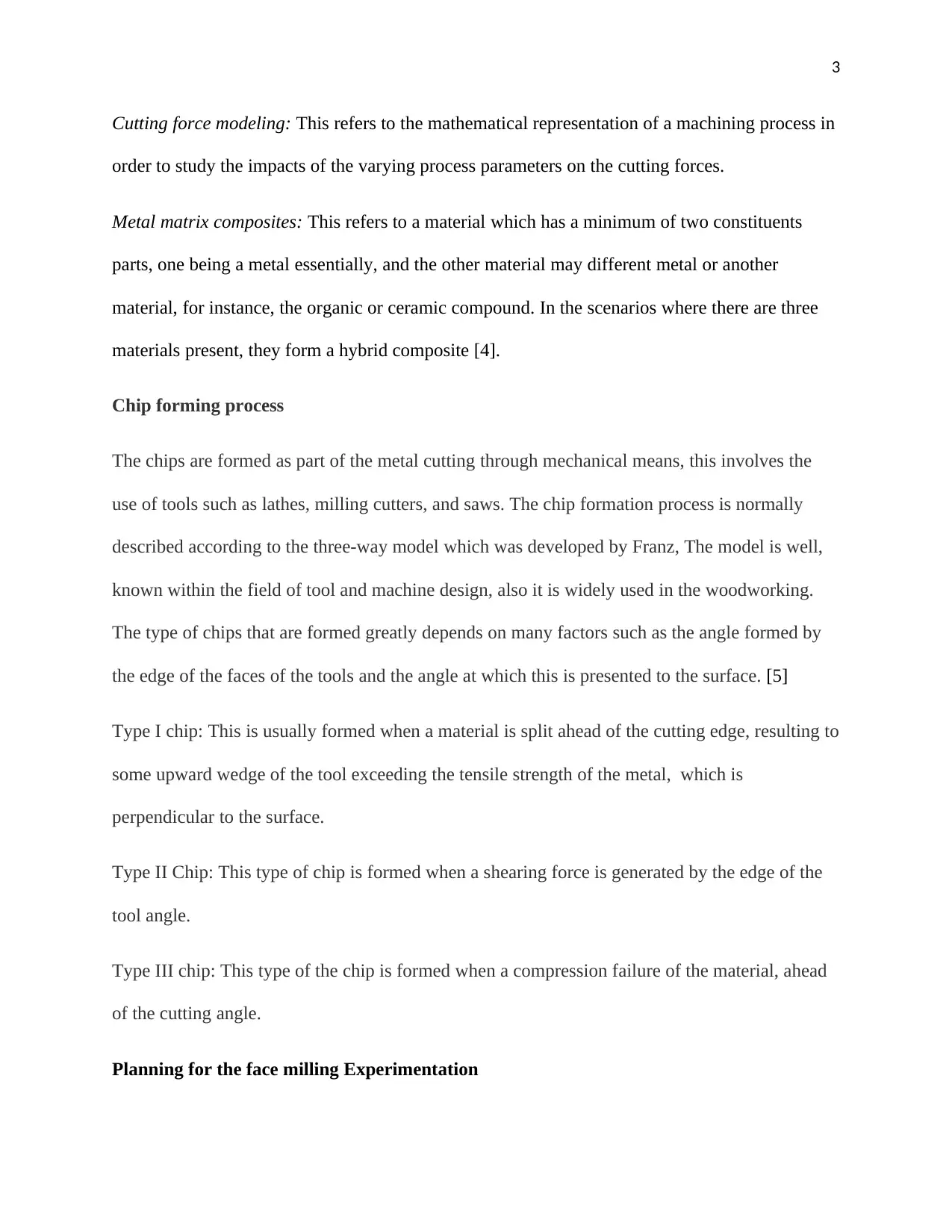
3
Cutting force modeling: This refers to the mathematical representation of a machining process in
order to study the impacts of the varying process parameters on the cutting forces.
Metal matrix composites: This refers to a material which has a minimum of two constituents
parts, one being a metal essentially, and the other material may different metal or another
material, for instance, the organic or ceramic compound. In the scenarios where there are three
materials present, they form a hybrid composite [4].
Chip forming process
The chips are formed as part of the metal cutting through mechanical means, this involves the
use of tools such as lathes, milling cutters, and saws. The chip formation process is normally
described according to the three-way model which was developed by Franz, The model is well,
known within the field of tool and machine design, also it is widely used in the woodworking.
The type of chips that are formed greatly depends on many factors such as the angle formed by
the edge of the faces of the tools and the angle at which this is presented to the surface. [5]
Type I chip: This is usually formed when a material is split ahead of the cutting edge, resulting to
some upward wedge of the tool exceeding the tensile strength of the metal, which is
perpendicular to the surface.
Type II Chip: This type of chip is formed when a shearing force is generated by the edge of the
tool angle.
Type III chip: This type of the chip is formed when a compression failure of the material, ahead
of the cutting angle.
Planning for the face milling Experimentation
Cutting force modeling: This refers to the mathematical representation of a machining process in
order to study the impacts of the varying process parameters on the cutting forces.
Metal matrix composites: This refers to a material which has a minimum of two constituents
parts, one being a metal essentially, and the other material may different metal or another
material, for instance, the organic or ceramic compound. In the scenarios where there are three
materials present, they form a hybrid composite [4].
Chip forming process
The chips are formed as part of the metal cutting through mechanical means, this involves the
use of tools such as lathes, milling cutters, and saws. The chip formation process is normally
described according to the three-way model which was developed by Franz, The model is well,
known within the field of tool and machine design, also it is widely used in the woodworking.
The type of chips that are formed greatly depends on many factors such as the angle formed by
the edge of the faces of the tools and the angle at which this is presented to the surface. [5]
Type I chip: This is usually formed when a material is split ahead of the cutting edge, resulting to
some upward wedge of the tool exceeding the tensile strength of the metal, which is
perpendicular to the surface.
Type II Chip: This type of chip is formed when a shearing force is generated by the edge of the
tool angle.
Type III chip: This type of the chip is formed when a compression failure of the material, ahead
of the cutting angle.
Planning for the face milling Experimentation
⊘ This is a preview!⊘
Do you want full access?
Subscribe today to unlock all pages.

Trusted by 1+ million students worldwide
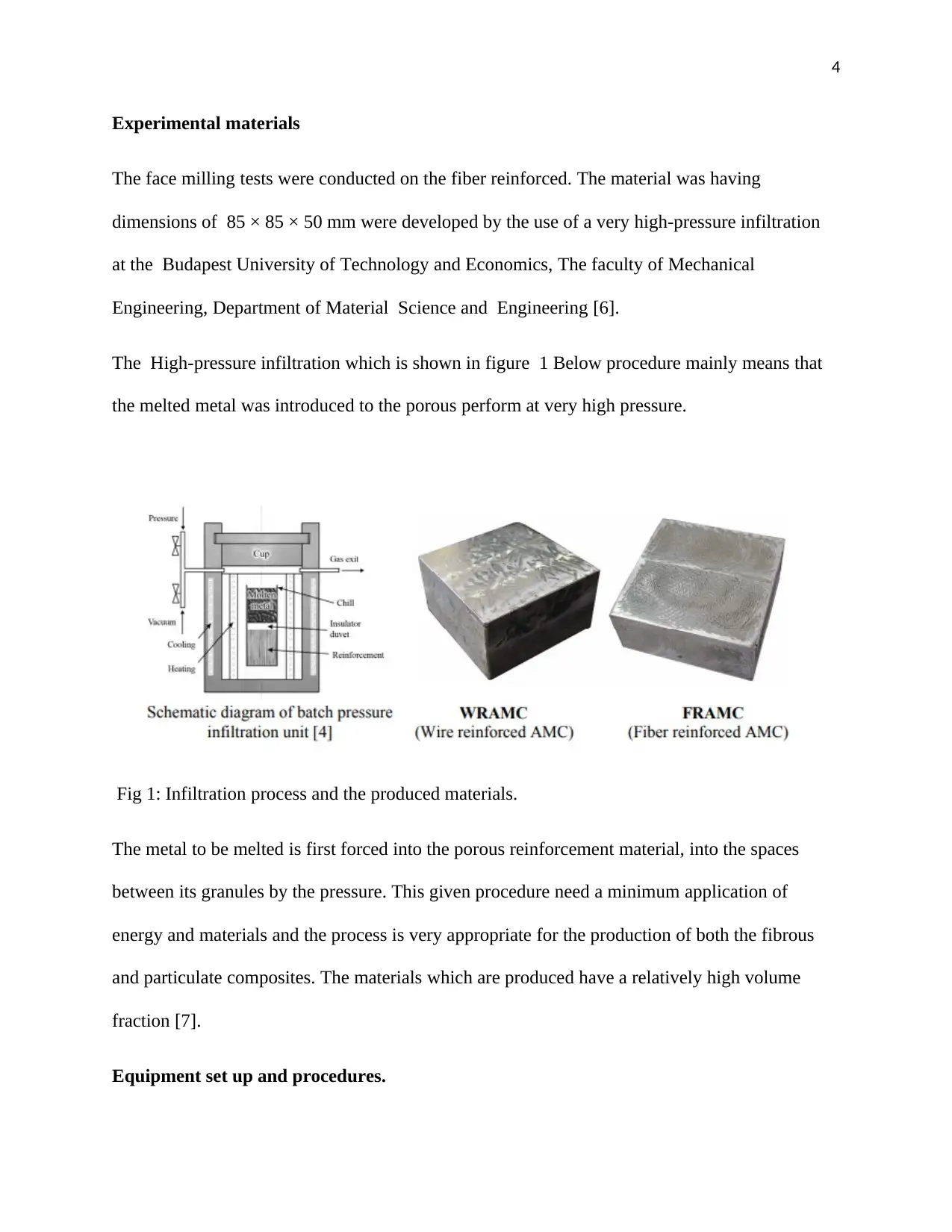
4
Experimental materials
The face milling tests were conducted on the fiber reinforced. The material was having
dimensions of 85 × 85 × 50 mm were developed by the use of a very high-pressure infiltration
at the Budapest University of Technology and Economics, The faculty of Mechanical
Engineering, Department of Material Science and Engineering [6].
The High-pressure infiltration which is shown in figure 1 Below procedure mainly means that
the melted metal was introduced to the porous perform at very high pressure.
Fig 1: Infiltration process and the produced materials.
The metal to be melted is first forced into the porous reinforcement material, into the spaces
between its granules by the pressure. This given procedure need a minimum application of
energy and materials and the process is very appropriate for the production of both the fibrous
and particulate composites. The materials which are produced have a relatively high volume
fraction [7].
Equipment set up and procedures.
Experimental materials
The face milling tests were conducted on the fiber reinforced. The material was having
dimensions of 85 × 85 × 50 mm were developed by the use of a very high-pressure infiltration
at the Budapest University of Technology and Economics, The faculty of Mechanical
Engineering, Department of Material Science and Engineering [6].
The High-pressure infiltration which is shown in figure 1 Below procedure mainly means that
the melted metal was introduced to the porous perform at very high pressure.
Fig 1: Infiltration process and the produced materials.
The metal to be melted is first forced into the porous reinforcement material, into the spaces
between its granules by the pressure. This given procedure need a minimum application of
energy and materials and the process is very appropriate for the production of both the fibrous
and particulate composites. The materials which are produced have a relatively high volume
fraction [7].
Equipment set up and procedures.
Paraphrase This Document
Need a fresh take? Get an instant paraphrase of this document with our AI Paraphraser
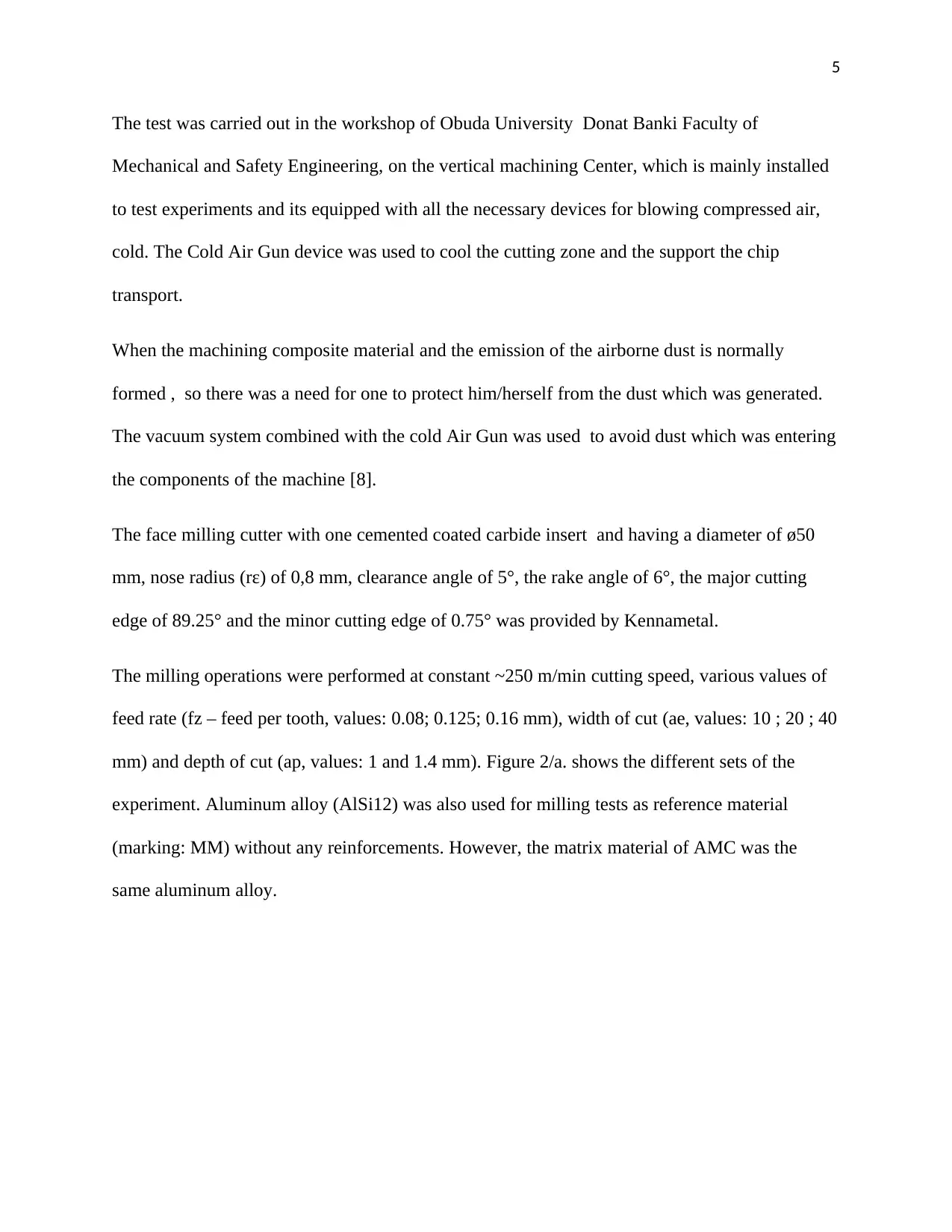
5
The test was carried out in the workshop of Obuda University Donat Banki Faculty of
Mechanical and Safety Engineering, on the vertical machining Center, which is mainly installed
to test experiments and its equipped with all the necessary devices for blowing compressed air,
cold. The Cold Air Gun device was used to cool the cutting zone and the support the chip
transport.
When the machining composite material and the emission of the airborne dust is normally
formed , so there was a need for one to protect him/herself from the dust which was generated.
The vacuum system combined with the cold Air Gun was used to avoid dust which was entering
the components of the machine [8].
The face milling cutter with one cemented coated carbide insert and having a diameter of ø50
mm, nose radius (rε) of 0,8 mm, clearance angle of 5°, the rake angle of 6°, the major cutting
edge of 89.25° and the minor cutting edge of 0.75° was provided by Kennametal.
The milling operations were performed at constant ~250 m/min cutting speed, various values of
feed rate (fz – feed per tooth, values: 0.08; 0.125; 0.16 mm), width of cut (ae, values: 10 ; 20 ; 40
mm) and depth of cut (ap, values: 1 and 1.4 mm). Figure 2/a. shows the different sets of the
experiment. Aluminum alloy (AlSi12) was also used for milling tests as reference material
(marking: MM) without any reinforcements. However, the matrix material of AMC was the
same aluminum alloy.
The test was carried out in the workshop of Obuda University Donat Banki Faculty of
Mechanical and Safety Engineering, on the vertical machining Center, which is mainly installed
to test experiments and its equipped with all the necessary devices for blowing compressed air,
cold. The Cold Air Gun device was used to cool the cutting zone and the support the chip
transport.
When the machining composite material and the emission of the airborne dust is normally
formed , so there was a need for one to protect him/herself from the dust which was generated.
The vacuum system combined with the cold Air Gun was used to avoid dust which was entering
the components of the machine [8].
The face milling cutter with one cemented coated carbide insert and having a diameter of ø50
mm, nose radius (rε) of 0,8 mm, clearance angle of 5°, the rake angle of 6°, the major cutting
edge of 89.25° and the minor cutting edge of 0.75° was provided by Kennametal.
The milling operations were performed at constant ~250 m/min cutting speed, various values of
feed rate (fz – feed per tooth, values: 0.08; 0.125; 0.16 mm), width of cut (ae, values: 10 ; 20 ; 40
mm) and depth of cut (ap, values: 1 and 1.4 mm). Figure 2/a. shows the different sets of the
experiment. Aluminum alloy (AlSi12) was also used for milling tests as reference material
(marking: MM) without any reinforcements. However, the matrix material of AMC was the
same aluminum alloy.
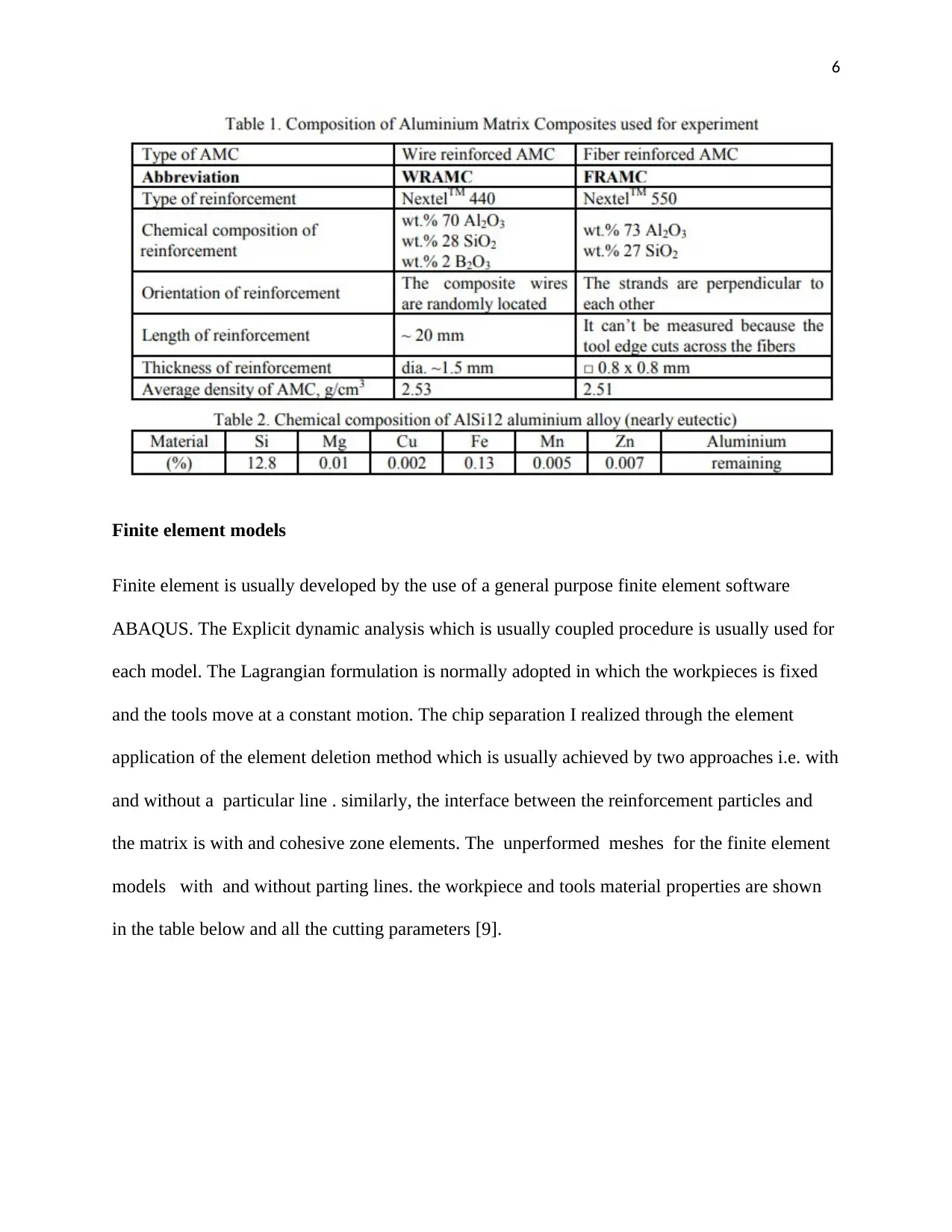
6
Finite element models
Finite element is usually developed by the use of a general purpose finite element software
ABAQUS. The Explicit dynamic analysis which is usually coupled procedure is usually used for
each model. The Lagrangian formulation is normally adopted in which the workpieces is fixed
and the tools move at a constant motion. The chip separation I realized through the element
application of the element deletion method which is usually achieved by two approaches i.e. with
and without a particular line . similarly, the interface between the reinforcement particles and
the matrix is with and cohesive zone elements. The unperformed meshes for the finite element
models with and without parting lines. the workpiece and tools material properties are shown
in the table below and all the cutting parameters [9].
Finite element models
Finite element is usually developed by the use of a general purpose finite element software
ABAQUS. The Explicit dynamic analysis which is usually coupled procedure is usually used for
each model. The Lagrangian formulation is normally adopted in which the workpieces is fixed
and the tools move at a constant motion. The chip separation I realized through the element
application of the element deletion method which is usually achieved by two approaches i.e. with
and without a particular line . similarly, the interface between the reinforcement particles and
the matrix is with and cohesive zone elements. The unperformed meshes for the finite element
models with and without parting lines. the workpiece and tools material properties are shown
in the table below and all the cutting parameters [9].
⊘ This is a preview!⊘
Do you want full access?
Subscribe today to unlock all pages.

Trusted by 1+ million students worldwide
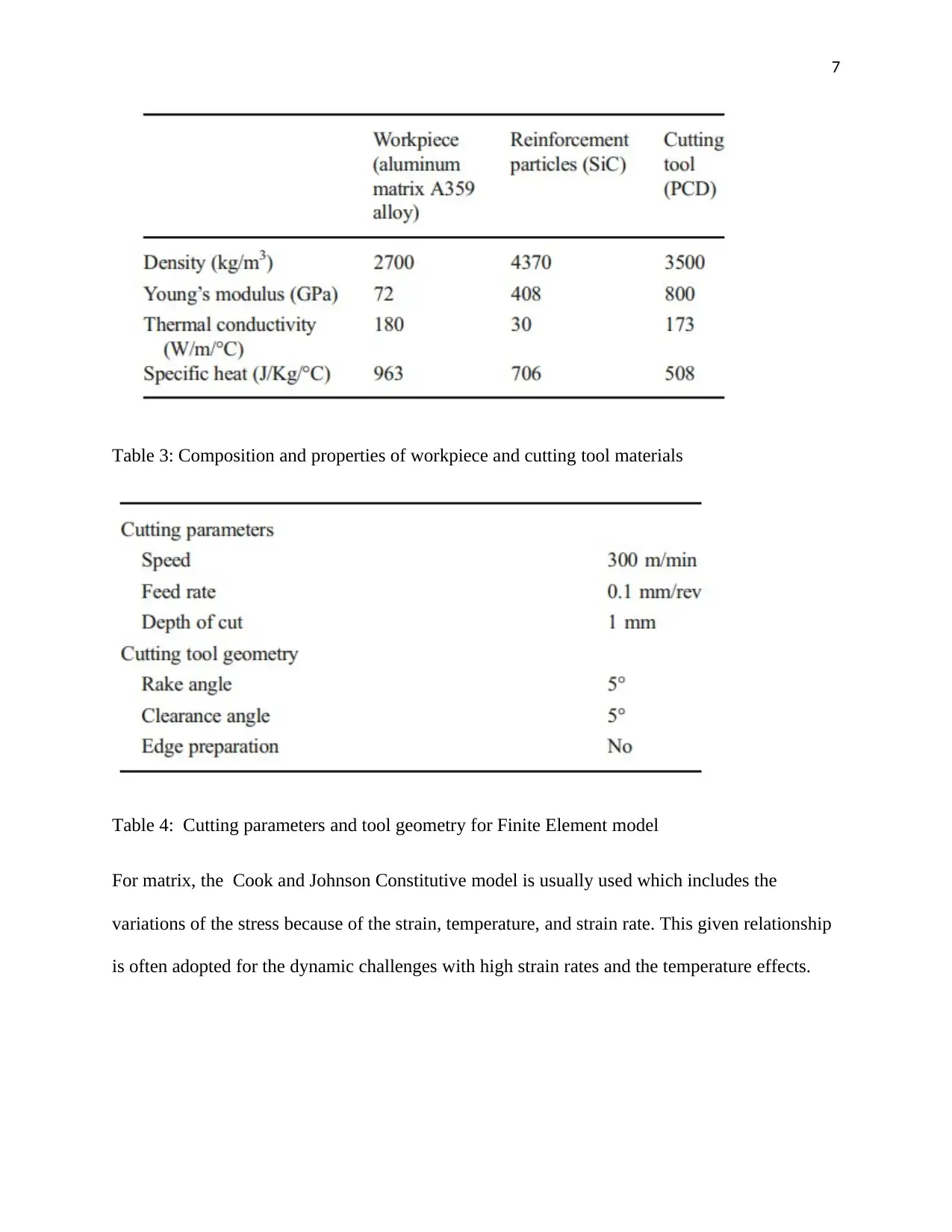
7
Table 3: Composition and properties of workpiece and cutting tool materials
Table 4: Cutting parameters and tool geometry for Finite Element model
For matrix, the Cook and Johnson Constitutive model is usually used which includes the
variations of the stress because of the strain, temperature, and strain rate. This given relationship
is often adopted for the dynamic challenges with high strain rates and the temperature effects.
Table 3: Composition and properties of workpiece and cutting tool materials
Table 4: Cutting parameters and tool geometry for Finite Element model
For matrix, the Cook and Johnson Constitutive model is usually used which includes the
variations of the stress because of the strain, temperature, and strain rate. This given relationship
is often adopted for the dynamic challenges with high strain rates and the temperature effects.
Paraphrase This Document
Need a fresh take? Get an instant paraphrase of this document with our AI Paraphraser
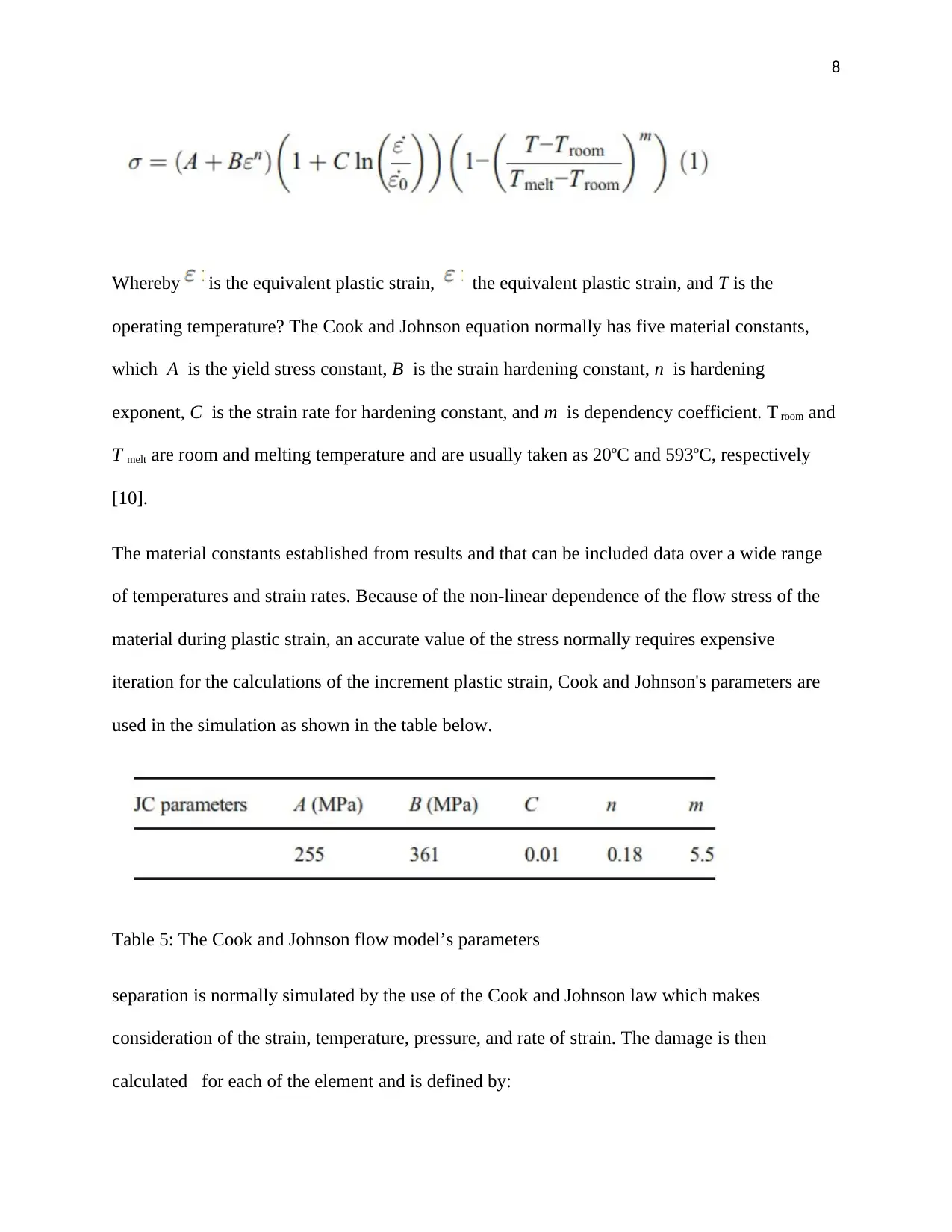
8
Whereby is the equivalent plastic strain, the equivalent plastic strain, and T is the
operating temperature? The Cook and Johnson equation normally has five material constants,
which A is the yield stress constant, B is the strain hardening constant, n is hardening
exponent, C is the strain rate for hardening constant, and m is dependency coefficient. T room and
T melt are room and melting temperature and are usually taken as 20oC and 593oC, respectively
[10].
The material constants established from results and that can be included data over a wide range
of temperatures and strain rates. Because of the non-linear dependence of the flow stress of the
material during plastic strain, an accurate value of the stress normally requires expensive
iteration for the calculations of the increment plastic strain, Cook and Johnson's parameters are
used in the simulation as shown in the table below.
Table 5: The Cook and Johnson flow model’s parameters
separation is normally simulated by the use of the Cook and Johnson law which makes
consideration of the strain, temperature, pressure, and rate of strain. The damage is then
calculated for each of the element and is defined by:
Whereby is the equivalent plastic strain, the equivalent plastic strain, and T is the
operating temperature? The Cook and Johnson equation normally has five material constants,
which A is the yield stress constant, B is the strain hardening constant, n is hardening
exponent, C is the strain rate for hardening constant, and m is dependency coefficient. T room and
T melt are room and melting temperature and are usually taken as 20oC and 593oC, respectively
[10].
The material constants established from results and that can be included data over a wide range
of temperatures and strain rates. Because of the non-linear dependence of the flow stress of the
material during plastic strain, an accurate value of the stress normally requires expensive
iteration for the calculations of the increment plastic strain, Cook and Johnson's parameters are
used in the simulation as shown in the table below.
Table 5: The Cook and Johnson flow model’s parameters
separation is normally simulated by the use of the Cook and Johnson law which makes
consideration of the strain, temperature, pressure, and rate of strain. The damage is then
calculated for each of the element and is defined by:
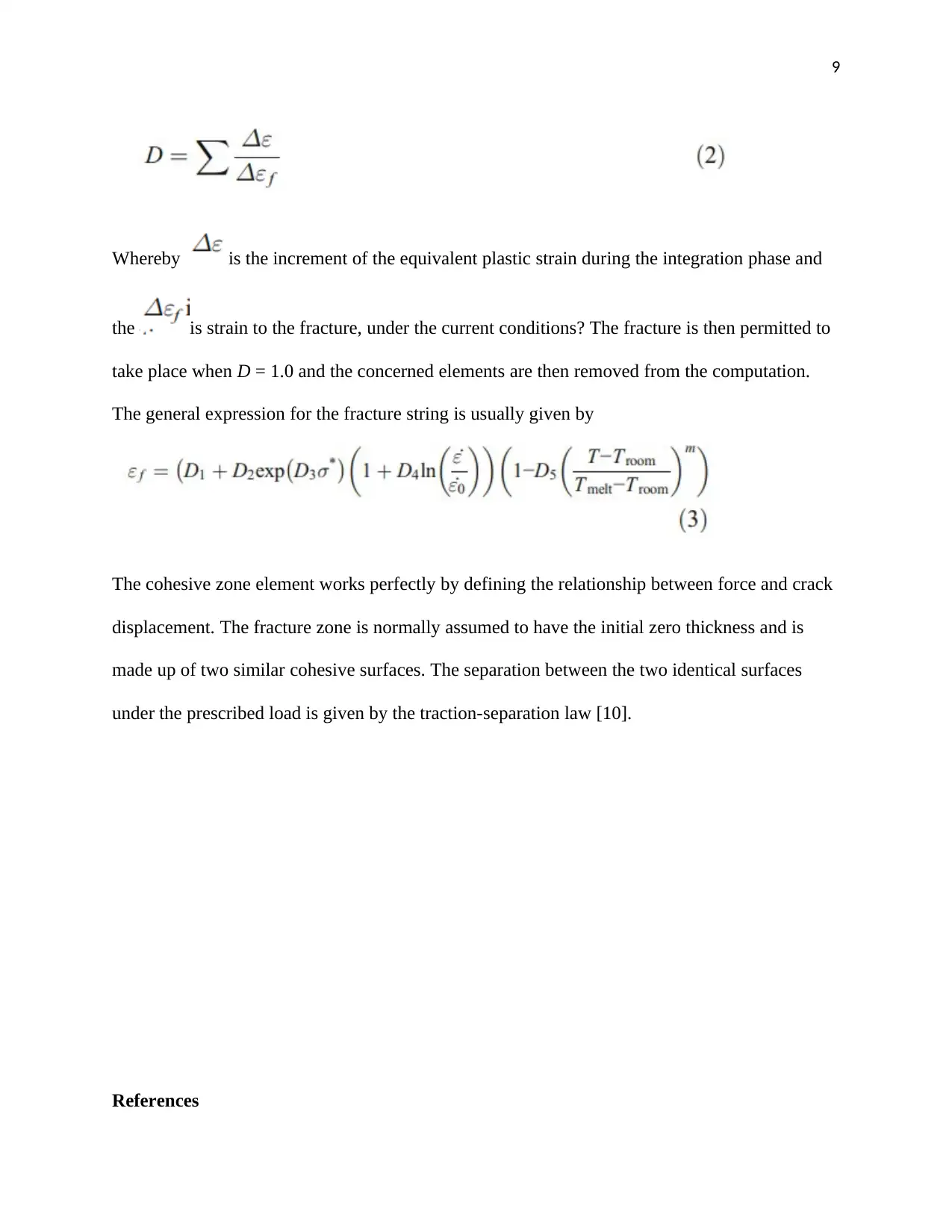
9
Whereby is the increment of the equivalent plastic strain during the integration phase and
the is strain to the fracture, under the current conditions? The fracture is then permitted to
take place when D = 1.0 and the concerned elements are then removed from the computation.
The general expression for the fracture string is usually given by
The cohesive zone element works perfectly by defining the relationship between force and crack
displacement. The fracture zone is normally assumed to have the initial zero thickness and is
made up of two similar cohesive surfaces. The separation between the two identical surfaces
under the prescribed load is given by the traction-separation law [10].
References
Whereby is the increment of the equivalent plastic strain during the integration phase and
the is strain to the fracture, under the current conditions? The fracture is then permitted to
take place when D = 1.0 and the concerned elements are then removed from the computation.
The general expression for the fracture string is usually given by
The cohesive zone element works perfectly by defining the relationship between force and crack
displacement. The fracture zone is normally assumed to have the initial zero thickness and is
made up of two similar cohesive surfaces. The separation between the two identical surfaces
under the prescribed load is given by the traction-separation law [10].
References
⊘ This is a preview!⊘
Do you want full access?
Subscribe today to unlock all pages.

Trusted by 1+ million students worldwide
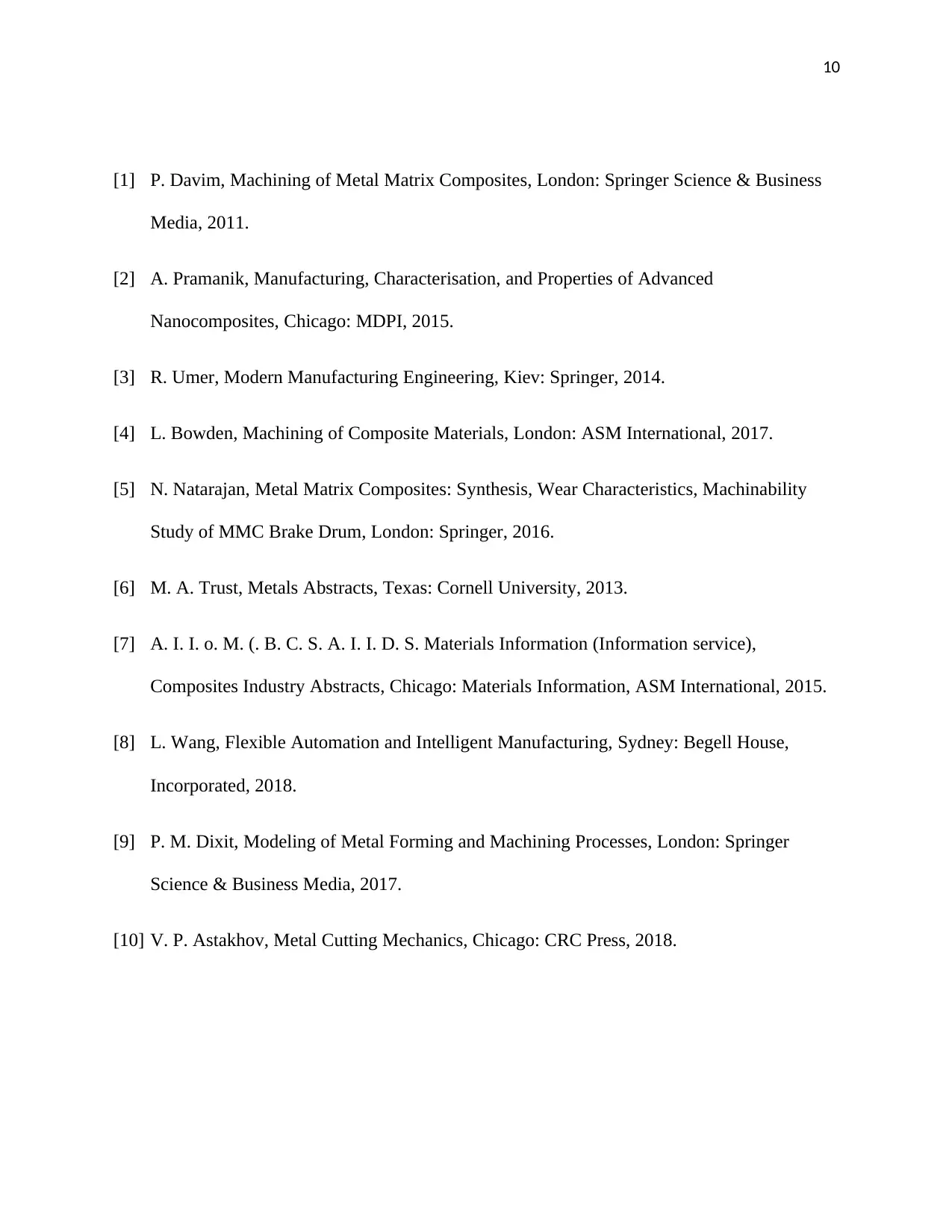
10
[1] P. Davim, Machining of Metal Matrix Composites, London: Springer Science & Business
Media, 2011.
[2] A. Pramanik, Manufacturing, Characterisation, and Properties of Advanced
Nanocomposites, Chicago: MDPI, 2015.
[3] R. Umer, Modern Manufacturing Engineering, Kiev: Springer, 2014.
[4] L. Bowden, Machining of Composite Materials, London: ASM International, 2017.
[5] N. Natarajan, Metal Matrix Composites: Synthesis, Wear Characteristics, Machinability
Study of MMC Brake Drum, London: Springer, 2016.
[6] M. A. Trust, Metals Abstracts, Texas: Cornell University, 2013.
[7] A. I. I. o. M. (. B. C. S. A. I. I. D. S. Materials Information (Information service),
Composites Industry Abstracts, Chicago: Materials Information, ASM International, 2015.
[8] L. Wang, Flexible Automation and Intelligent Manufacturing, Sydney: Begell House,
Incorporated, 2018.
[9] P. M. Dixit, Modeling of Metal Forming and Machining Processes, London: Springer
Science & Business Media, 2017.
[10] V. P. Astakhov, Metal Cutting Mechanics, Chicago: CRC Press, 2018.
[1] P. Davim, Machining of Metal Matrix Composites, London: Springer Science & Business
Media, 2011.
[2] A. Pramanik, Manufacturing, Characterisation, and Properties of Advanced
Nanocomposites, Chicago: MDPI, 2015.
[3] R. Umer, Modern Manufacturing Engineering, Kiev: Springer, 2014.
[4] L. Bowden, Machining of Composite Materials, London: ASM International, 2017.
[5] N. Natarajan, Metal Matrix Composites: Synthesis, Wear Characteristics, Machinability
Study of MMC Brake Drum, London: Springer, 2016.
[6] M. A. Trust, Metals Abstracts, Texas: Cornell University, 2013.
[7] A. I. I. o. M. (. B. C. S. A. I. I. D. S. Materials Information (Information service),
Composites Industry Abstracts, Chicago: Materials Information, ASM International, 2015.
[8] L. Wang, Flexible Automation and Intelligent Manufacturing, Sydney: Begell House,
Incorporated, 2018.
[9] P. M. Dixit, Modeling of Metal Forming and Machining Processes, London: Springer
Science & Business Media, 2017.
[10] V. P. Astakhov, Metal Cutting Mechanics, Chicago: CRC Press, 2018.
1 out of 10
Related Documents
Your All-in-One AI-Powered Toolkit for Academic Success.
+13062052269
info@desklib.com
Available 24*7 on WhatsApp / Email
![[object Object]](/_next/static/media/star-bottom.7253800d.svg)
Unlock your academic potential
Copyright © 2020–2025 A2Z Services. All Rights Reserved. Developed and managed by ZUCOL.





